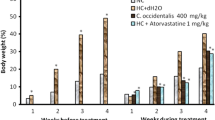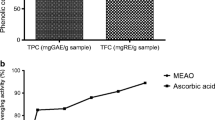Abstract
Musa sapientum Linn. (English ‘Banana’ family Musaceae), is a plant with nutritive, as well as medicinal value. Antihypercholesterolemic and antioxidant effect of methanolic extract of stem of this plant was investigated in hypercholesterolemic rats. Rats were made hypercholesterolemic by feeding cholesterol (100 mg/kg/day) suspended in soya oil. Treatment groups received extract at a dose of 10, 20 and 40 mg/kg/day in addition to cholesterol orally once daily. Fasting blood samples were collected before and after 6 weeks treatment. Animals were sacrificed and liver stored at -80 °C. Total cholesterol, HDL-cholesterol and triacylglycerol were estimated in blood. Malondialdehyde, reduced glutathione, superoxide dismutase and catalase were measured in blood and liver. Total lipids, HMG CoA redutase and lipoprotein lipase were investigated in liver. Most effective dose was found to be 20 mg/kg/day. Rise in total cholesterol, LDL + VLDL-cholesterol and triacylglycerol in animals receiving only cholesterol was 179 %, 417 % and 74 % respectively, while in animals receiving 20 mg/kg dose rise in these parameters was restricted to 40 %, 106 % and 24 %. HDL-cholesterol decreased by 12 % in extract treated group, while it decreased to 36 % in untreated hypercholesterolemic rats. Malonaldialdehyde, marker of lipid peroxidation decreased while reduced glutathione and enzymes superoxide dismutase and catalase increased significantly in blood and liver (p < 0.01). Total lipids in liver decreased and enzymes of lipid metabolism viz. HMG CoA redutase and lipoprotein lipase were restored to near normal. Gas chromatography mass spectroscopy indicated high content of sterols in extract. Study demonstrated that methanol extract of stem of Musa sapientum has significant antihypercholesterolemic and antioxidant effects.



Similar content being viewed by others
References
Aebi H (1984) Catalase in vitro. Methods Enzymol 105:121–126
Ahmed I, Lakhani MS, Gillett M, John A, Raza H (2001) Hypotriglyceridemic and hypocholesterolemic effects of anti-diabetic momordica charantia (karela) fruit extract in streptozotocin-induced diabetic rats. Diabetes Res Clin Pract 51(3):155–161
Batta AK, Xu G, Bollineni JS, Shefer S, Salen G (2005) Effect of high plant sterol-enriched diet and cholesterol absorption inhibitor, SCH 58235, on plant sterol absorption and plasma concentrations in hypercholesterolemic wild-type Kyoto rats. Metabolism 54(1):38–48
Beutler E, Duron O, Kelly BM (1963) Improved method for the determination of bloodglutathione. J Lab Clin Med 61:882–888
Bhaskar JJ, Salimath PV, Nandini CD (2011) Stimulation of glucose uptake by Musa sp.(cv. Elakki bale) flower and pseudostem extracts in Ehrlich ascites tumor cells. J Sci Food Agric 91(8):1482–1487
Chau VM, Phan VK, Nguyen X, Nguyen XC, Nguyen PT, Nguyen HN, le TA H, Do CT, Thuy DT, Kang HK, Jang HD, Kim YH (2011) Cytotoxic and antioxidant activities of diterpenes and sterols from the Vietnamese soft coral Lobophytum compactum. Bioorg Med Chem Lett 21(7):2155–2159
Dikshit P, Tyagi MK, Shukla K, Sharma S, Gambhir JK, Shukla R (2011) Hepatoprotective effect of stem of Musa sapientum Linn in rats intoxicated with carbon tetrachloride. Ann Hepatol 10(3):333–339
Dikshit P, Shukla K, Tyagi MK, Garg P, Gambhir JK, Shukla R (2012) Antidiabetic and antihyperlipidemic effects of the stem of Musa sapientum Linn. In streptozotocin-induced diabetic rats. J Diabetes 4(4):378–385
Ellman GL (1959) Tissue sulfhydryl groups. Arch Biochem Biophys 82(1):70–77
Farias RAF, Neto MFO, Viana GSB, Rao VSN (1996) Effects of croton cajucara extract on serum lipids of rats fed a high fat diet. Phytother Res 10:697–699
Folch J, Lees M, Sloane Stanley GH (1957) A simple method for the isolation and purification of total lipids from animal tissues. J Biol Chem 226(1):497–509
Gomathy R, Vijayalekshmi NR, Kurup PA (1989) Hypolipidemic principle of the inflorescence stalk of plantain Musa sapientum. J Biosci 14(3):301–309
Gomathy R, Vijayalekshmi NR, Kurup PA (1990) Hypoglycemic action of the pectin present in the juice of the inflorescence stalk of plantain (Musa sapientum) mechanism of action. J Biosci 15:297–303
Gosain S, Ircchiaya R, Sharma PC, Thareja S, Kalra A, Deep A, Bhardwaj TR (2010) Hypolipidemic effect of ethanolic extract from the leaves of hibiscus sabdariffa L. in hyperlipidemic rats. Acta Pol Pharm 67(2):179–184
Gupta R, Singhal S, Goyle A, Sharma VN (2001) Antioxidant and hypocholesterolaemic effects of terminalia arjuna tree-bark powder: a randomised placebo-controlled trial. J Assoc Physicians India 49:231–235
Gupta S, Mediratta PK, Singh S, Sharma KK, Shukla R (2006) Antidiabetic, antihypercholesterolaemic and antioxidant effect of Ocimum sanctum (Linn) seed oil. Indian J Exp Biol 44(4):300–304
Johansen O, Vaaler S, Jorde R, Reikerås O (1994) Increased plasma glucose levels after hypnorm anaesthesia, but not after pentobarbital anaesthesia in rats. Lab Anim 28(3):244–248
Katan MB, Grundy SM, Jones P, Law M, Miettinen T, Paoletti R, Participants SW (2003) Efficacy and safety of plant stanols and sterols in the management of blood cholesterol levels. Mayo Clin Proc 78(8):965–978
Kumar V, Singh P, Chander R, Mahdi F, Singh S, Singh R, Khanna AK, Saxena JK, Mahdi AA, Singh VK (2009) Hypolipidemic activity of hibiscus Rosa sinensis root in rats. Indian J Biochem Biophys 46(6):507–510
Küskü-Kiraz Z, Mehmetçik G, Dogru-Abbasoglu S, Uysal M (2010) Artichoke leaf extract reduces oxidative stress and lipoprotein dyshomeostasis in rats fed on high cholesterol diet. Phytother Res 24(4):565–570
Nandi A, Chatterjee IB (1988) Assay of superoxide dismutase activity in animal tissues. J Biosci 13:305–315
Patil RH, Prakash K, Maheshwari VL (2010) Hypolipidemic effect of celastrus paniculatus in experimentally induced hypercholesterolemic wistar rats. Indian J Clin Biochem 25(4):405–410
Patwardhan B, Warude D, Pushpangadan P, Bhatt N (2005) Ayurveda and traditional Chinese medicine: a comparative overview. Evid Based Complement Alternat Med 2(4):465–473
Rao AV, Ramakrishnan S (1975) Indirect assessment of hydroxymethylglutaryl-CoA reductase (NADPH) activity in liver tissue. Clin Chem 21(10):1523–1525
Satoh K (1978) Serum lipid peroxide in cerebrovascular disorders determined by a new colorimetric method. Clin Chim Acta 90(1):37–43
Satyavati GV, Gupta AK, Tandon N (eds) (1987) Medicinal plants of India volume 2. Indian Council of Medical Research New Delhi pp 299–303
Shukla R, Gupta S, Gambhir JK, Prabhu KM, Murthy PS (2004) Antioxidant effect of aqueous extract of the bark ofFicus bengalensis in hypercholesterolaemic rabbits. J Ethnopharmacol 92(1):47–51
Sinha AK (1972) Colorimetric assay of catalase. Anal Biochem 47(2):389–394
Sofowora EA (1993) Phytochemical Assays in “Medicinal Plants and Traditional Medicine in Africa”, 3rd edn. Spectrum Books Limited, Nigeria, pp. 150–153
Sorg DA, Buckner B (1964) A simple method of obtaining venous blood from small laboratory animals. Proc Soc Exp Biol Med 115:1131–1132
Tan MH, Johns D, Glazer NB (2004) Pioglitazone reduces atherogenic index of plasma in patients with type 2 diabetes. Clin Chem 50(7):1184–1188
Tietz NW, Fiereck EA (1972) In: Cooper, G R (ed) Standard methods of clinical chemistry, Vol. 7. Academic Press, New York, pp 19
Vogiatzi G, Tousoulis D, Stefanadis C (2009) The role of oxidative stress inatherosclerosis. Hell J Cardiol 50(5):402–409
Wills ED (1966) Mechanisms of lipid peroxide formation in animal tissues. Biochem J 99(3):667–676
Yokozawa T, Ishida A, Cho EJ, Nakagawa T (2003) The effects of coptidis rhizoma extract on a hypercholesterolemic animal model. Phytomedicine 10(1):17–22
Zhang Q, Chang Z, Yang J, Wang Q (2008) Antiatherogenic property of triterpenoids-enriched extract from the aerial parts of salvia miltiorrhiza. Phytother Res 22(8):1040–1045
Acknowledgments
The authors acknowledge the Indian Council of Medical Research, New Delhi for providing financial assistance. (Grant No. - 45/26/2009/BMS/TRM).
Author information
Authors and Affiliations
Corresponding author
Ethics declarations
Conflict of interest
The authors declare that they have no conflict of interest.
Additional information
Research highlights
• Musa sapientum (English ‘Banana), is a plant with nutritive, as well as medicinal value.
• Effects of methanolic extract of stem of this plant were evaluated in cholesterol fed rats.
• It was found to have significant antihypercholesterolemic and antioxidant effect.
• Extract contain phenolics, tannins, terpenoids and steroids.
• GC-MS studies indicated extract to be rich in sterols.
Rights and permissions
About this article
Cite this article
Dikshit, P., Tyagi, M.K., Shukla, K. et al. Antihypercholesterolemic and antioxidant effect of sterol rich methanol extract of stem of Musa sapientum (banana) in cholesterol fed wistar rats. J Food Sci Technol 53, 1690–1697 (2016). https://doi.org/10.1007/s13197-015-2096-5
Accepted:
Published:
Issue Date:
DOI: https://doi.org/10.1007/s13197-015-2096-5




